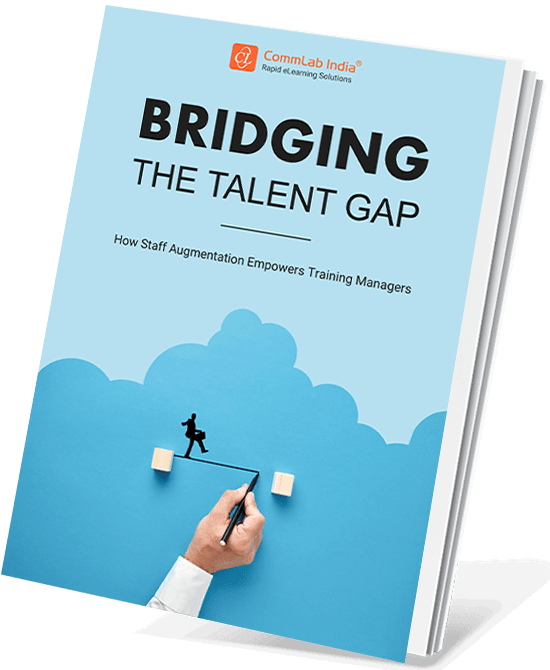Why is Staff Augmentation an Ideal Choice for L&D Staffing?

How do you manage when your learning and development (L&D) team faces an unexpected surge in training needs? Whether it’s a new product launch or a sudden regulatory change, the ability to scale your training efforts quickly is essential. However, traditional hiring processes are often too slow and costly to meet these urgent demands. This is where **Staff Augmentation** can make a significant difference.
→ Download eBook: Bridging the Talent Gap: How Staff Augmentation Empowers Training Managers
Table of Contents
- What is Staff Augmentation in L&D?
- Why Choose Staff Augmentation Over Traditional Hiring?
- Is Staff Augmentation Cost-Effective for L&D?
- Can Staff Augmentation Improve Project Delivery in L&D?
- How to Implement Staff Augmentation in Your L&D Strategy?
Staff Augmentation allows you to bring in skilled professionals on a temporary basis, providing the flexibility and expertise needed to handle both short-term spikes and long-term projects. By leveraging this approach, organizations can ensure that their training programs are delivered efficiently, without overburdening their existing teams. In this blog, we’ll explore why Staff Augmentation is the smart choice for L&D professionals, offering a balanced solution to the challenges of scaling training operations in today’s fast-paced business environment.
What is Staff Augmentation in L&D?
What is Staff Augmentation in L&D?
Staff Augmentation refers to the practice of temporarily hiring skilled professionals to supplement an organization's existing workforce. It differs from traditional hiring in that these professionals are brought in on a short-term basis, often to address specific projects or periods of high demand.
Unlike outsourcing, where entire tasks or functions are handed off to an external agency, Staff Augmentation involves integrating these temporary experts directly into your existing team. In the context of Learning and Development (L&D), Staff Augmentation allows organizations to quickly scale their training teams by bringing in instructional designers, eLearning developers, trainers, and other specialists as needed.
Why Does Staff Augmentation Matter?
In today’s fast-paced corporate training environment, Staff Augmentation offers several key benefits including:
- Flexibility: Companies can adjust their training resources based on current needs, whether for a short-term project like a product launch or a longer-term initiative such as rolling out a new learning management system.
- Cost-Efficiency: Staff Augmentation avoids the long-term financial commitments associated with full-time hires. Organizations pay for expertise only when it's needed, without the overhead costs of permanent employment.
- Expertise on Demand: L&D departments can access a wide range of specialized skills, from advanced eLearning development to niche industry knowledge, without the time-consuming process of traditional hiring.
- Speed: The ability to quickly bring in qualified professionals allows organizations to respond swiftly to changes, ensuring that training initiatives are delivered on time and meet business objectives.
In summary, Staff Augmentation in L&D is a strategic tool that allows organizations to maintain agility, control costs, and access the right expertise at the right time, making it highly relevant in today’s dynamic business environment.
Why Choose Staff Augmentation Over Traditional Hiring?
What Are the Challenges of Traditional Hiring for L&D?
Hiring full-time Learning and Development (L&D) staff comes with a host of challenges that can hinder a company's ability to respond swiftly to changing training needs:
- Time-Consuming Process: Traditional hiring can be a lengthy process. From crafting job descriptions and posting them to interviewing candidates and making offers, it can take weeks or even months to find the right person. During this time, critical corporate training initiatives may be delayed, impacting business outcomes.
- High Costs: Hiring full-time employees involves significant costs beyond just salaries. Recruitment expenses, benefits, onboarding, and training add up quickly. For small to mid-sized businesses, these costs can strain budgets, especially when the need for additional staff is temporary.
- Resource Constraints: Once a full-time employee is hired, the organization is responsible for ensuring they have enough work to justify their position. This can lead to situations where staff members are underutilized if projects wrap up sooner than anticipated or if the demand for training fluctuates.


Bridging the Talent Gap: How Staff Augmentation Empowers Training Managers
Craft a Dream Team of Exceptional Experts, Meticulously Suited to your Requirements!
- Advantages and Considerations of Staff Augmentation
- L&D Roles that Benefit from Staff Augmentation
- Staff Augmentation Process
- Success Stories
How Does Staff Augmentation Provide Flexibility in L&D?
Staff Augmentation offers a flexible solution to these challenges by allowing companies to scale their L&D teams according to project demands:
- Scalability: Staff Augmentation enables businesses to quickly adjust their workforce. Whether a company needs to ramp up for a large-scale training rollout or downsize after a project concludes, this approach provides the agility to do so without the long-term commitment of full-time hires.
- Cost-Efficiency: With Staff Augmentation, companies only pay for the skills and expertise they need when they need them. This approach eliminates the costs associated with long-term employment and ensures that resources are allocated effectively.
- Access to Specialized Skills: L&D projects often require niche expertise that may not be available in-house. Whether it’s for a short-term project like developing a new eLearning module or integrating a new LMS, Staff Augmentation allows companies to bring in specialized talent quickly and efficiently.
- Faster Time-to-Market: By leveraging Staff Augmentation, businesses can accelerate project timelines. Since these professionals are often experts in their fields, they require minimal onboarding and can start contributing immediately. This means training programs can be developed and deployed faster, keeping the organization ahead of the competition.

In summary, while traditional hiring has its place, the flexibility, cost-efficiency, and speed offered by Staff Augmentation make it a superior choice for many L&D projects. By enabling organizations to bring in the right talent at the right time, Staff Augmentation helps businesses stay agile, ensuring that they can meet training needs effectively without the long-term commitments and costs associated with full-time hires. This strategic approach not only optimizes resources but also ensures that L&D initiatives are delivered on time and within budget, driving better outcomes for the organization.
Is Staff Augmentation Cost-Effective for L&D?
What Are the Financial Benefits of Staff Augmentation?
Staff Augmentation offers distinct financial advantages that make it a smart alternative to traditional hiring models:
- Optimized Resource Allocation: With Staff Augmentation, companies only pay for the talent they need, precisely when they need it. This eliminates the costs associated with full-time employees, such as benefits and retirement contributions, allowing organizations to allocate budgets more efficiently toward specific requirements.
- Streamlined Recruitment: Traditional hiring involves lengthy and costly processes—advertising, interviewing, and onboarding. Staff Augmentation simplifies this by providing immediate access to skilled professionals, reducing both time and financial expenditure.
- Flexible Scalability: Scaling a workforce traditionally requires significant financial outlays, whether hiring during peak periods or laying off during downturns. Staff Augmentation offers a cost-effective solution by allowing organizations to adjust staff levels seamlessly, ensuring that costs align with actual needs.
How Does Staff Augmentation Reduce Overhead Costs?
Staff Augmentation can significantly reduce overhead costs, positively impacting an organization’s bottom line:
- Lower Administrative Costs: Full-time employees come with a range of administrative responsibilities, including payroll management, benefits administration, and HR support. These tasks require dedicated staff and resources. By using Staff Augmentation, companies can minimize these administrative burdens, as augmented staff are typically managed by an external provider. This allows the organization to focus on core business functions rather than getting bogged down in administrative tasks.
- Elimination of Training Costs: New full-time employees often require extensive training to get up to speed, which can be both time-consuming and costly. In contrast, Staff Augmentation professionals are usually highly experienced and require minimal onboarding. They can jump into projects quickly, reducing the need for costly and time-intensive training programs.
- Reduced Infrastructure Costs: Full-time employees necessitate additional workspace, equipment, and other infrastructure investments. For organizations that may not have the capacity to expand their physical space, these costs can be prohibitive. Staff Augmentation allows companies to bring in external talent without the need for additional office space or equipment, as these professionals can often work remotely or bring their own resources.
Consider a mid-sized corporation that faces a sudden increase in training demands due to a new product launch. The company initially considers hiring full-time instructional designers to meet the demand but quickly realizes the associated costs—salaries, benefits, workspace, and equipment—would stretch their budget thin. Instead, they opt for **Staff Augmentation**. By bringing in experienced instructional designers on a temporary basis, they not only meet their training needs quickly but also save on recruitment and infrastructure costs. These designers work remotely, reducing the need for additional office space and equipment. Once the product launch is complete and training demands decrease, the company easily scales down without the financial burden of laying off full-time staff. This flexibility and cost-effectiveness demonstrate how **Staff Augmentation** can be a smart financial strategy for organizations looking to manage L&D costs while maintaining agility.
In summary, Staff Augmentation offers a cost-effective solution for L&D by optimizing resource allocation, reducing recruitment and administrative costs, and eliminating the need for extensive training and infrastructure investments. This approach enables organizations to maintain financial flexibility while effectively addressing their training needs.

Bridging the Talent Gap: How Staff Augmentation Empowers Training Managers
Craft a Dream Team of Exceptional Experts, Meticulously Suited to your Requirements!
- Advantages and Considerations of Staff Augmentation
- L&D Roles that Benefit from Staff Augmentation
- Staff Augmentation Process
- Success Stories
Can Staff Augmentation Improve Project Delivery in L&D?
Staff Augmentation can significantly enhance project delivery in L&D by impacting both timelines and the quality of deliverables. Here’s how:
What Impact Does Staff Augmentation Have on Project Timelines?
- Faster Project Completion: Staff Augmentation allows organizations to quickly bring in specialized talent, speeding up tasks that might otherwise be delayed. This leads to quicker project completion, helping meet tight deadlines.
- Flexible Resource Allocation: Organizations can adjust resources according to the project's needs. For example, more instructional designers might be required during the design phase, while developers are needed later. This ensures the right expertise is available at each stage, optimizing timelines.
A company faces a tight deadline to roll out a compliance training program across multiple regions. By using Staff Augmentation, they quickly bring in additional instructional designers and developers, completing the project ahead of schedule. Without this approach, the project would likely have faced significant delays, risking regulatory non-compliance.
How Does Staff Augmentation Enhance the Quality of L&D Deliverables?
- Access to Specialized Expertise: Staff Augmentation provides access to niche skills that might not be available in-house. This ensures high-quality deliverables, especially in specialized areas like gamification or microlearning.
- Focused Team Effort: By bringing in external experts, the in-house team can focus on their core strengths, leading to higher quality work. External professionals often introduce fresh perspectives, enhancing the overall quality of the project.
An organization is developing a leadership training program but lacks experience in VR simulations. Through Staff Augmentation, they bring in a VR specialist who helps create immersive simulations, resulting in a cutting-edge training program. The program is highly praised for its innovative approach, something that would not have been possible without the additional expertise.
In summary, Staff Augmentation not only accelerates project timelines but also elevates the quality of L&D deliverables, ensuring successful outcomes for both employees and the organization.
How to Implement Staff Augmentation in Your L&D Strategy?
Implementing Staff Augmentation in your L&D strategy begins with clearly identifying your staffing needs. Here’s how to get started:
What Steps Should You Take to Identify Your Staffing Needs?
- Assess Your Current Workforce: Analyze your existing L&D team's strengths and weaknesses. Identify any skill gaps that might impact your upcoming projects.
- Define Project Requirements: Outline the specific skills, expertise, and roles needed for your upcoming projects. Whether it’s instructional design, eLearning development, or project management, clarity is key.
- Prioritize Needs: Determine which roles are most critical for the success of your projects. Focus on areas where external talent can make the biggest impact, such as specialized instructional design or advanced tech skills.
- Set a Budget: Estimate the budget for augmenting your team. Consider not only the cost of external talent but also the value they bring in terms of efficiency and quality.

Bridging the Talent Gap: How Staff Augmentation Empowers Training Managers
Craft a Dream Team of Exceptional Experts, Meticulously Suited to your Requirements!
- Advantages and Considerations of Staff Augmentation
- L&D Roles that Benefit from Staff Augmentation
- Staff Augmentation Process
- Success Stories
How to Choose the Right Staff Augmentation Partner?
Selecting the right Staff Augmentation partner is crucial to ensure seamless integration and project success. Here’s a checklist to guide your selection:
- Evaluate Experience and Expertise: Look for partners with proven experience in L&D, particularly in areas like instructional design and online training development. Ask for case studies or references to gauge their expertise.
- Assess Cultural Fit: Ensure the partner’s work culture aligns with your organization’s values and goals. A good cultural fit promotes better collaboration and understanding.
- Review Flexibility and Scalability: Choose a partner who can scale resources up or down based on your project needs. This flexibility ensures that you have the right talent at the right time.
- Check Support and Communication: Effective communication is key. Ensure the partner provides regular updates and has a reliable support system in place for any challenges that arise.
By following these steps, you can effectively implement Staff Augmentation in your L&D strategy, ensuring that you have the right talent in place to meet your project goals and deliver high-quality learning experiences.
Is Staff Augmentation a Necessity for Corporate Training?
Wrapping Up
Staff Augmentation offers L&D teams a strategic advantage, enabling them to respond quickly to evolving training needs. By bringing in specialized talent, such as instructional designers or eLearning developers, organizations can enhance the quality and efficiency of their training programs. This approach provides flexibility in scaling resources, reduces overhead costs, and ultimately drives better business outcomes. Whether you're facing tight deadlines or need to fill skill gaps, Staff Augmentation ensures that your projects are completed on time and with the highest standards.
Ready to bridge the talent gap in your L&D department? Discover how Staff Augmentation can empower training managers to deliver impactful learning experiences by exploring our guide, "Bridging the Talent Gap: How Staff Augmentation Empowers Training Managers." Embrace the future of corporate training by ensuring your team has the right talent at the right time.





